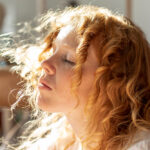When it comes to textured hair color in Boston, finding the right balance between vibrant shades and curl health can feel tricky.
Whether you have coils, curls, or waves, Boston’s mix of humidity, heat, and cold winters can all impact how your hair color behaves, sometimes leaving your strands feeling dry or dull.
That’s why understanding the science of coloring textured hair is essential. Textured strands have unique porosity levels and curl patterns, requiring specialized techniques and moisture-rich care to maintain their appearance.
By following professional guidance and selecting the right color approach, you can enhance your texture while maintaining healthy and radiant curls.
What is Textured Hair Coloring?

Textured hair has a unique curl pattern and structure, meaning it reacts differently to color than straight hair. When you color textured strands, the chemicals used, such as ammonia and hydrogen peroxide, open the cuticle layer, allowing pigments to enter.
While this process creates beautiful color, it can also strip away natural moisture. That’s why understanding the science behind textured hair coloring is crucial.
Studies show that curly and coily hair types are more prone to dryness and breakage due to the uneven distribution of natural oils along the strand. When adding color, professional care becomes essential to maintain hair health and shine.
💡 Tip: Always work with a professional hair color specialist who understands textured hair structure and how to balance pigment, porosity, and moisture retention for your unique curl pattern.
The Dos For Coloring Textured Hair

Ready to embrace a new shade? Follow these dos for long-lasting, healthy results:
1. Always Book a Professional Consultation
Before undergoing any color treatment, schedule a consultation with a professional hairstylist to ensure a personalized approach. They’ll assess your curl type, porosity, and current condition to determine what techniques and shades will work best for you.
2. Deep Condition Before and After Coloring
Textured hair thrives on moisture. Using treatments like deep conditioning a few days before your appointment helps strengthen your strands, allowing them to absorb color more evenly. After coloring, continue to use deep conditioning regularly to maintain softness and bounce.
3. Use Gentle, Professional-Grade Products
Salon formulas are designed to protect textured hair while achieving rich, even tones. Learn more about why this matters in our guide on salon color vs box dye — it could save your curls from severe damage.
4. Keep Your Scalp Healthy
A healthy scalp = healthy hair. Incorporate scalp care routines into your regimen to minimize dryness, flaking, and irritation that can occur after color treatments.
5. Invest in Moisture-Locking Leave-Ins
Your best friend post-color? A leave-in conditioner that nourishes your curls without weighing them down. Try the TXTUR Leave-In Conditioner to hydrate and protect your color while keeping curls defined and frizz-free.
The Don’ts for Textured Hair Color

1. Don’t DIY Bleach or Box Dye
Textured hair is delicate, and bleaching at home can lead to breakage, uneven color, and frizz. Always leave the lifting process to professionals — especially when going lighter.
2. Don’t Over-Process Your Hair
Spacing out your color sessions is crucial. Overlapping treatments or frequent touch-ups can dry out your hair and weaken your curl pattern.
3. Don’t Skip Aftercare
Coloring is only the beginning; maintaining it is what keeps your hair healthy and vibrant. Regular moisturizing, using sulfate-free shampoos, and applying heatless styles can make a huge difference. Need inspiration? Discover these heatless styling tips for preserving your curls while maintaining their gorgeousness.
Popular Textured Hair Coloring Techniques in Boston

Boston stylists are experts in blending creativity with curl care. Here are some trending textured hair coloring techniques you might love:
- Balayage for curls: Adds dimension and movement while maintaining a natural look.
- Lived-in highlights: Perfect for effortlessly chic, low-maintenance styles.
- Gloss or toner treatments: Refresh faded color and restore shine.
- Color melting: Smoothly transitions between tones for a sun-kissed finish.
If you’re in the area, consider booking your appointment at Haste Hair Boston for expert care that enhances both your texture and color.
How to Maintain Colored Textured Hair

Once your new color is in, the real magic is in the maintenance. Here’s how to keep your hair vibrant and healthy long-term:
Sleep Smart: Use a satin or silk bonnet or pillowcase to reduce friction and moisture loss overnight.
Hydrate Regularly: Incorporate lightweight moisturizers and oils to maintain elasticity.
Scalp Massages: Boost circulation to encourage healthy regrowth and distribute oils evenly.
Wash Wisely: Stick to sulfate-free shampoos and cool water rinses to preserve your color.
Avoid Excess Heat: If you must use heat, always apply a protectant and keep the temperature low.
Schedule Regular Treatments: Book professional treatments at Haste Hair every few weeks to replenish hydration and refresh your color.
Ready to Transform Your Curls?
Textured hair deserves color that celebrates your natural beauty, not hides it. By working with a professional hair color specialist in Boston, you can achieve rich, lasting color while keeping your curls healthy and strong.
👉 Book your next color appointment today at Haste Hair Boston and experience the art of textured hair color done right.
Embrace your unique hair texture while experimenting with colors to achieve head-turning results.
FAQ
How often should I color my textured hair?
Every 8–12 weeks is ideal, depending on your color and hair condition. Regular trims and deep conditioning in between will help maintain vibrancy.
Can I color my textured hair at home?
It’s possible, but not recommended. Professional colorists understand curl patterns and porosity — and can help you achieve consistent, safe results.
How can I keep my curl pattern intact after coloring?
Moisture is key! Deep condition weekly, use a leave-in like TXTUR’s Leave-In Conditioner, and avoid heat styling when possible.
What’s the best way to refresh my color without re-dyeing?
Opt for a gloss or toner treatment every few months to add shine and revive faded color without additional damage.









